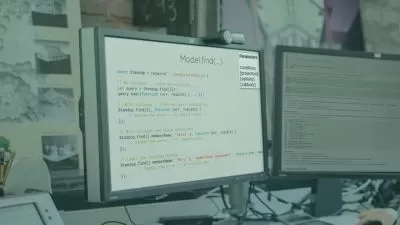Leveling up as node.js developer - Advanced nodejs 2024
Kal T
8:59:08
Description
Advanced nodejs masterclass - Nodejs best practices, code architecture, database optimization, performance, security.
What You'll Learn?
- Understand nodejs at a great depth and confidently appear in interviews.
- Have an excellent understanding of software architecture and structure your code like a pro.
- Learn the practical challenges of building modern software development such as securing your app and improving your application performance.
- Complete 43 exercise files that are designed to teach you advanced mechanisms like caching, query optimization, and clean coding to build a robust application.
- Boost your confidence and get ready for your next nodejs project.
Who is this for?
What You Need to Know?
More details
DescriptionAre you ready to take your Node.js expertise to new heights? Leveling up as a Nodejs developer is now released. The first release contains nine well-curated sections to give you the most valuable skills to stand out in the job market and build your confidence. The course will give you a 100% new perspective on Node.JS, a collection of tips and hacks to build the cleanest, structured, robust, secure, high-performing, and optimized application that you will ever encounter. I have worked very hard on the course for about a year now, to give you the most fun and memorable learning experience.Â
Course outline:-
1. Mastering the basics — setting the right mindset
We start the course by covering some of the fundamentals that play a crucial role in shaping how you should view node.js and some must-know basic concepts that you should know before moving to the next sections.
2. Making the most out of node.js
This is one is the most interesting sections which deeply dives into what is behind the cool node.js we have been using and covers concepts and tools that move node.js to go beyond its capacity. It also gives a practical overview of what node.js is good and bad at and what we should do in scenarios where node.js doesn’t do quite well.
3. Structuring and architecting your code
I remember when I first got into node.js I didn’t know how to organize my code and was looking for resources that could teach me how to do so. I couldn’t find one at the time and I just went with what I had so I had to learn through time and experience and of course with the help of other senior developers. It has been 7 years now and I still can’t find a course specifically made for structuring your code in node.js so I used the chance to create this section containing 16 videos dedicated to creating a boilerplate code that you can refer to any time you start a project.
4. Authentication best practices
In this section, I covered important topics that you need to know to integrate a successful authentication system. This section is not only about authentication but also explains how your authentication system can fit into the architecture you created.
5. Securing your node.js application
Security is the most dismissed aspect of software development by a lot of developers. I understand the urge to just jump into building the next cool project but with great power comes great responsibility and it is one of those things that can elevate your confidence in whatever system you launch. So in this section, I covered the most common and also the least known vulnerabilities and how you can protect your node.js code against them. Again everything that comes after the section “structuring and architecting your code†considers how it can fit within the boilerplate code structure.
6. Clean coding and advanced architectural principles
This section is a bit different from the above section “Structuring and architecting your code†as it covers clean coding tools, consistency, formatting, and different architectural principles that you can pull out and use in different scenarios.
7. Improving the performance of your node.js application
I think the title explains itself. But this is one of my favorite sections with 13+ videos navigating through tools and techniques that are useful to make your application faster so that your beloved users enjoy the experience of high throughput.
8. Database query optimization
This one is the shortest section but is as important as the other sections. It covers ways to optimize and speed up your MongoDB query.
The course won’t end here I aim to add more interesting sections I wish I could add them all at once but Mother Time has its beautiful way of limiting us so I will release them one by one. I have these titles in mind but you can also suggest or vote on which one you like the most.
Unit Testing
Scaling
API Integration
Debugging
Node.JS Interview Questions
The New Version Features
Using Cloud Services To Optimize Your Node.JS App
Alright, that is all, see you!
Who this course is for:
- This is the right course for you if you know the basics of javascript, nodejs, and Rest API’s and you are looking for a material to improve your skill, have a full image on different aspect of software development and confidently appear in interviews.
Are you ready to take your Node.js expertise to new heights? Leveling up as a Nodejs developer is now released. The first release contains nine well-curated sections to give you the most valuable skills to stand out in the job market and build your confidence. The course will give you a 100% new perspective on Node.JS, a collection of tips and hacks to build the cleanest, structured, robust, secure, high-performing, and optimized application that you will ever encounter. I have worked very hard on the course for about a year now, to give you the most fun and memorable learning experience.Â
Course outline:-
1. Mastering the basics — setting the right mindset
We start the course by covering some of the fundamentals that play a crucial role in shaping how you should view node.js and some must-know basic concepts that you should know before moving to the next sections.
2. Making the most out of node.js
This is one is the most interesting sections which deeply dives into what is behind the cool node.js we have been using and covers concepts and tools that move node.js to go beyond its capacity. It also gives a practical overview of what node.js is good and bad at and what we should do in scenarios where node.js doesn’t do quite well.
3. Structuring and architecting your code
I remember when I first got into node.js I didn’t know how to organize my code and was looking for resources that could teach me how to do so. I couldn’t find one at the time and I just went with what I had so I had to learn through time and experience and of course with the help of other senior developers. It has been 7 years now and I still can’t find a course specifically made for structuring your code in node.js so I used the chance to create this section containing 16 videos dedicated to creating a boilerplate code that you can refer to any time you start a project.
4. Authentication best practices
In this section, I covered important topics that you need to know to integrate a successful authentication system. This section is not only about authentication but also explains how your authentication system can fit into the architecture you created.
5. Securing your node.js application
Security is the most dismissed aspect of software development by a lot of developers. I understand the urge to just jump into building the next cool project but with great power comes great responsibility and it is one of those things that can elevate your confidence in whatever system you launch. So in this section, I covered the most common and also the least known vulnerabilities and how you can protect your node.js code against them. Again everything that comes after the section “structuring and architecting your code†considers how it can fit within the boilerplate code structure.
6. Clean coding and advanced architectural principles
This section is a bit different from the above section “Structuring and architecting your code†as it covers clean coding tools, consistency, formatting, and different architectural principles that you can pull out and use in different scenarios.
7. Improving the performance of your node.js application
I think the title explains itself. But this is one of my favorite sections with 13+ videos navigating through tools and techniques that are useful to make your application faster so that your beloved users enjoy the experience of high throughput.
8. Database query optimization
This one is the shortest section but is as important as the other sections. It covers ways to optimize and speed up your MongoDB query.
The course won’t end here I aim to add more interesting sections I wish I could add them all at once but Mother Time has its beautiful way of limiting us so I will release them one by one. I have these titles in mind but you can also suggest or vote on which one you like the most.
Unit Testing
Scaling
API Integration
Debugging
Node.JS Interview Questions
The New Version Features
Using Cloud Services To Optimize Your Node.JS App
Alright, that is all, see you!
Who this course is for:
- This is the right course for you if you know the basics of javascript, nodejs, and Rest API’s and you are looking for a material to improve your skill, have a full image on different aspect of software development and confidently appear in interviews.
User Reviews
Rating
Kal T
Instructor's Courses
Udemy
View courses Udemy- language english
- Training sessions 88
- duration 8:59:08
- Release Date 2024/03/04











